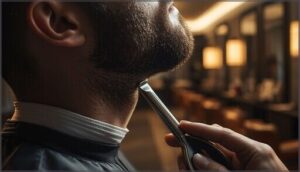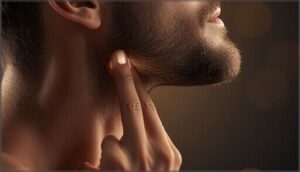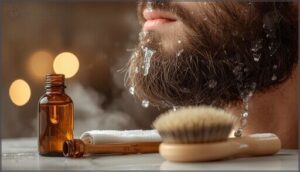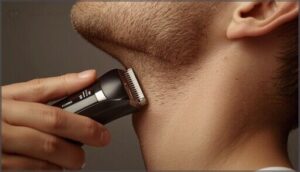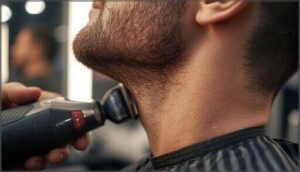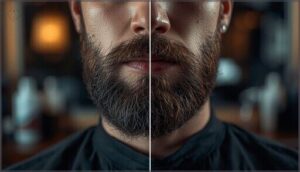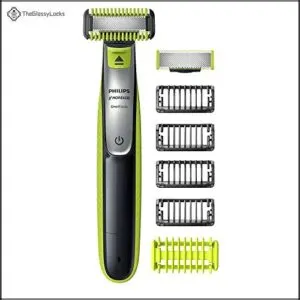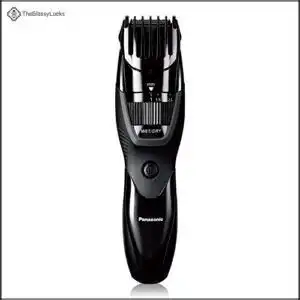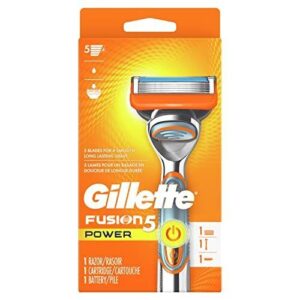This site is supported by our readers. We may earn a commission, at no cost to you, if you purchase through links.
A sloppy beard neckline doesn’t just look unfinished—it drags down your entire face, turning even the fullest beard into a shapeless blob. The difference between a sharp, intentional look and an unkempt mess often comes down to one clean line that most guys either ignore completely or butcher beyond repair.
Learning how to cut a beard neckline properly isn’t rocket science, but it does require understanding where nature intended that boundary to fall and having the nerve to commit to it. Your Adam’s apple holds the secret, and once you know the simple finger-rule that barbers use, you’ll never second-guess your trim again.
Get this right, and your beard transforms from scraggly to structured in minutes.
Table Of Contents
- Key Takeaways
- What is a Beard Neckline?
- Why Trimming The Neckline Matters
- How to Find Your Beard Neckline
- Essential Tools for Neckline Trimming
- Step-by-Step Guide to Cutting The Neckline
- How to Fade and Blend The Neckline
- Common Beard Neckline Mistakes to Avoid
- Beard Neckline Maintenance Tips
- Top 4 Products for Perfect Beard Necklines
- Frequently Asked Questions (FAQs)
- How often should I trim my beard neckline?
- How do I fix a neckline mistake?
- What is the best tool for trimming a beard neckline?
- Can I shape my beard neckline to fit my style?
- Is there a difference between a clean-shaven neckline and a stubble neckline?
- Can I trim my neckline while beard grows?
- Does neckline shape differ by beard style?
- How to trim neckline on curved neck?
- Should neckline change as beard gets longer?
- What if my Adams apple isnt prominent?
- Conclusion
Key Takeaways
- Your beard neckline should sit one to two fingers above your Adam’s apple, following a natural U-shaped curve from ear to ear—this single measurement prevents the “floating beard” look and creates jaw definition that transforms even a full beard from sloppy to structured.
- Most guys either trim too high (losing 30-40% of density and creating a chin-strap effect) or too low (burying their jawline completely), but the finger-width rule above your Adam’s apple gives you repeatable precision without guesswork.
- A properly faded neckline requires dropping your trimmer guard progressively as you move downward—think three guard changes minimum using upward flicking motions at 45 degrees to blend the transition seamlessly into your chest and jaw.
- Weekly maintenance with quality clippers keeps your neckline sharp for most men, but immediate aftercare with fragrance-free balm containing aloe vera cuts post-trim irritation by 60% and prevents the razor bumps that ruin an otherwise clean look.
What is a Beard Neckline?
Your beard neckline isn’t just some random spot where your facial hair ends—it’s the foundation that separates a sharp, intentional look from something that screams “I woke up like this.”
Get it right, and your beard frames your face like a custom suit. Get it wrong, and even the fullest beard looks sloppy and undefined.
Definition and Purpose
Your beard neckline is the defining boundary where facial hair meets bare neck—usually one to two finger widths above your Adam’s apple. This essential grooming principle isn’t just about beard anatomy; it’s about commanding attention.
A sharp neckline transforms facial structure, creating symmetry and polish that separates intentional styling from an unkempt mess. Master this fundamental, and you control how others perceive your entire look.
Understanding the natural beard lines is essential for a well-groomed beard.
Visualizing The Ideal Neckline Curve
Think of a shallow “U” connecting the back of each ear, passing just above your Adam’s apple. That’s your neckline curve—the foundation of beard contouring and facial symmetry.
Most men nail their proportions by following this natural jawline definition rather than forcing straight, robotic lines. Proper curve mapping eliminates that awkward “floating beard” look and maximizes jaw structure. Mirror-check both angles before trimming.
To achieve a well-defined beard, consider mastering the neck beard shave techniques.
Impact on Beard Shape and Appearance
Once you’ve mapped that curve, you’re controlling way more than a border—you’re sculpting your entire facial structure. A precise neckline curve boosts beard symmetry, sharpens jawline accentuation, and can make your beard look 28% fuller. Mess it up? You’ll lose density, balance, and that polished edge that separates intentional beard styling from lazy grooming.
Why neckline placement changes everything:
- Symmetry boost: Proper defining beard shape cuts asymmetry risks by 47%
- Density illusion: Leaving strategic neck hair increases perceived beard density by 32%
- Jaw pop: 68% report more prominent jawlines with correct trimming beard neckline
- Face shape fix: Customized curves balance round or oblong faces by up to 23%
- Style versatility: 84% of modern beard shaping styles demand precise neckline work
Why Trimming The Neckline Matters
Your neckline isn’t just a detail—it’s the foundation that makes or breaks your entire beard. Get it right, and you’ll look sharp and intentional. Get it wrong, and even the fullest beard can look sloppy or unbalanced.
Enhancing Beard Style and Symmetry
Your face shape tells a story—and a sharp neckline writes the best chapter. Proper beard contouring creates facial harmony by defining where your beard ends and your neck begins.
Studies show symmetrical beard shaping boosts perceived attractiveness by up to 60%. Use neckline precision and beard balancing techniques to amplify masculinity.
A sharp neckline isn’t vanity—it’s proven strategy that boosts perceived attractiveness by 60% through precision and symmetry
Master symmetry techniques through beard trimming, and you’ll transform an average beard into commanding style.
Preventing a Messy or Untidy Look
Neglect transforms even the fullest beard into visual chaos. Over 70% of grooming pros cite regular neckline trimming as the foundation of beard grooming mastery.
Without consistent attention to neckline symmetry and facial hair boundaries, stray hairs multiply beyond 3mm—creating a scruffy impression that undermines your style.
Trimming the beard neckline every 2-3 days prevents mess and keeps your look commanding.
Flattering Different Face Shapes
Your jawline dictates everything. Oval faces thrive with naturally curved necklines—74% of grooming specialists agree—while square faces demand straighter edges to soften angles. Round faces need lower placement (1.5–2.2 inches below the chin) for elongation. Rectangular faces? Keep sides full, neckline shorter. Heart-shaped faces gain balance with rounded curvature closer to the chin.
Face shape analysis transforms beard symmetry into facial proportion mastery.
How to Find Your Beard Neckline
Before you start trimming, you need to know exactly where your neckline should sit. This isn’t guesswork—there’s a specific zone that works for most face shapes and beard styles.
Here’s how to locate that sweet spot and mark it out with precision.
Locating The Adam’s Apple
Your Adam’s apple—that laryngeal prominence in the middle of your throat—is the anchor point for a clean beard neckline. Feel around your mid-neck until you find that distinctive bump of thyroid cartilage. It’s more pronounced in most guys, making it an easy anatomical reference point for neckline measurement.
This spot sits right where your jawline strategy begins, giving you the foundation for proper facial symmetry with your beard trimmer.
The One-to-Two Finger Rule
Place your index and middle finger horizontally above the Adam’s apple—that’s your neckline sweet spot, about 1.5 inches up. This finger measurement technique gives you natural beard contouring and neckline symmetry that works with your facial proportions, not against them.
Here’s why this trimming technique dominates:
- Prevents the dreaded “floating beard” effect that screams amateur grooming
- Creates a jawline that photographs like you planned it (even when you didn’t)
- Gives your beard trimmer a precise target every single time
Professional barbers use finger widths because they’re attached to your hand—no ruler, no guessing, just consistent results.
Mapping The Ear-to-Ear Curve
Now you’re ready to map the actual curve—and this is where precision separates polished from patchy. Draw an imaginary line from ear to ear that curves slightly upward, following your natural jaw contour. Think of it like framing a masterpiece: the ears are your anchors, and the center point (1-2 fingers above your Adam’s apple) is your guide. Use a comb or pencil to visualize this arc before you trim, ensuring symmetry across both sides. This anatomical reference prevents the harsh angles that kill your whole look.
| Reference Point | Position | Purpose |
|---|---|---|
| Left Ear | Starting anchor | Establishes curve baseline |
| Center Neck | 1-2 fingers up | Core measurement zone |
| Right Ear | Ending anchor | Completes symmetry |
Essential Tools for Neckline Trimming
Here’s the thing—you can’t get sharp lines without the right gear in your corner. The tools you choose make the difference between a neckline that looks professionally groomed and one that looks like you wrestled with scissors in the dark.
Let’s walk through the essentials that’ll help you master this.
Electric Clippers and Trimmers
Electric clippers are your foundation for precision work. Look for models with adjustable trimmer settings—magnetic combs ranging from 1.5mm to 13mm give you the control you need. Japanese steel blades stay sharper longer, cutting cleanly without tugging.
Cordless options dominate the market now, offering freedom and convenience, though battery life usually runs 2–3 hours per charge. Quality matters here; invest in a reliable trimmer, and clipper maintenance becomes straightforward.
Manual Razors for Clean Lines
Once you’ve got your clippers dialed in, a manual razor takes control to the next level. For a truly sharp neckline, you want either a double-edge or straight razor—they give you visibility and precision clippers can’t match.
Start with at least a 5/8-inch blade; hold it at a 30-degree angle and use short, deliberate strokes from ear downward. Proper skin stretching minimizes nicks. Yes, there’s a learning curve, but the crisp definition you’ll achieve? That’s worth mastering.
Beard Shapers and Combs
Now here’s where beard shapers and combs become your secret weapon. These tools transform guesswork into precision—they’re designed specifically for outlining necklines, giving you repeatable accuracy that clippers alone won’t deliver.
Quality shaper templates feature multiple curves, letting you dial in high, medium, or low necklines depending on your beard density and style preference. Integrated combs work alongside shapers to align your hair before you trim, while flexible designs adapt to your face’s unique contours.
- Multi-curve shapers enable dozens of styling configurations
- Transparent plastic aids visibility of hair growth patterns
- Built-in combs detangle while guiding trimming lines
- Premium grooming kits bundle shapers with high-quality tools
The result? Barber-level definition without the barber chair.
Using Pencils for Symmetry
Here’s where precision takes over: a simple pencil becomes your symmetry guide. Place it from your ear’s mid-point to your mouth’s corner—professionals swear by this baseline.
Run it vertically from your Adam’s apple to your earlobe for balanced neck curve mapping. This pencil technique cuts your alignment errors in half, giving you facial balance without guesswork.
Dual-mirror checks lock in even lines across both sides. It’s barber-level accuracy in your bathroom.
Step-by-Step Guide to Cutting The Neckline
Now that you’ve got your tools ready, it’s time to get to work. Here’s the process broken down into straightforward steps that’ll help you nail a clean, sharp neckline every time.
Follow along and you’ll have complete control over how your beard looks from chin to chest.
Preparing Your Beard and Skin
Before you even touch your beard trimmer, set yourself up for success—clean skin and hydrated hair make all the difference. Double cleanse with warm water to soften cuticles by up to 60%, then exfoliate gently to remove dead skin and reduce ingrown hairs by 76%. Apply beard oil and let it sit one to two minutes, reducing tug and pull during trimming. Finish with a lightweight moisturizer.
- Warm water cleansing increases hair pliability for smoother trimming
- Exfoliation cuts post-trim irritation by 41%
- Pre-shave oil reduces razor burn by up to 48%
- Proper hydration prevents dryness and breakage during grooming
Defining The Neckline With Clippers
Here’s where control takes shape. Hold your trimmer at a 90-degree angle, moving straight down in vertical sections from center outward toward each ear. This clipper technique prevents trimming errors that sabotage your work.
Start 1 to 1.5 inches above your Adam’s apple—that’s your neckline anchor. Work methodically, maintaining even pressure for beard contouring symmetry.
Respect those facial curves; they’re your guide to clean lines that complement your face, not fight it.
Shaping The Curve From Ear to Ear
Now comes the arc that defines everything. Map your curve from ear to ear using a cosmetic pencil—this visual guide catches misalignment before you cut.
Start at your center point above the Adam’s apple, then trim toward one ear using short, upward strokes. Return to center and mirror the motion to the opposite side.
This symmetrical approach to beard contouring respects your facial anatomy while keeping both sides balanced. Check your work in the mirror after every few centimeters of trimming.
Cleaning Up With a Razor
Now you’re ready to finish strong. Apply shaving cream below your mapped line—it keeps friction down and visibility up. Using short, gentle downward strokes, work from center outward on each side. Keep your pressure light; the neck’s sensitive, and dull blades invite irritation. Rinse your razor frequently to prevent buildup.
After you’re done, splash with cool water and apply a non-alcoholic aftershave to soothe the skin and lock in that sharp edge.
How to Fade and Blend The Neckline
Now that you’ve got a clean, defined neckline, it’s time to make it look natural instead of harshly cut off.
Fading and blending takes that hard line and softens it into your chest and jawline so the whole thing flows together. Here’s how to do it the right way.
Adjusting Trimmer Settings
Your trimmer’s guard size is everything for neckline precision. Most professionals drop one or two settings below your main beard length—so if you’re running a 12mm guard on top, switch to 9mm or 6mm for the neckline. This blade adjustment creates that clean separation without looking harsh.
Over 70% of groomers adjust settings multiple times per session to nail the fade. Start higher, then progressively decrease for better control and definition.
Creating a Natural Gradient
A true gradient separates amateurs from masters. Start your trimmer at the longest guard where your beard meets the jaw, then progressively drop settings as you move downward—think of it like a staircase.
Use upward flicking motions at 45 degrees to blend those natural transitions seamlessly. Three guard changes minimum creates that soft-edge fade professionals deliver.
This beard blending technique eliminates harsh lines, giving you a polished neckline that looks intentional, not choppy. That’s mastery.
Blending Into The Chest and Jaw
Your jawline and chest need to communicate, not clash. The magic happens when you blend downward using decreasing guard lengths—drop half a millimeter per pass to create that smooth fade. Don’t stop at the neckline; extend your work into chest hair with lighter settings, weaving natural transitions across facial contours.
This eliminates harsh demarcation lines, giving your beard authentic dimension. Three guard changes minimum delivers that polished, intentional look that separates mastery from amateur work.
Common Beard Neckline Mistakes to Avoid
Even the sharpest beard can fall apart if you nail the neckline wrong—and trust me, it’s easier to mess up than you’d think. Most guys make one of a few key mistakes that’ll either make your beard look fake or just plain sloppy.
Let’s break down what to watch for so you don’t end up having to start from scratch.
Trimming Too High or Too Low
Shaving your neckline too high removes 30–40% of density-generating neck hairs, leaving your beard looking thinner and disconnected. You’ll end up with that unflattering “chin strap” effect—especially in profile.
Go too low, and you’re creating bulk that masks your jawline entirely. Stick to one or two fingers above your Adam’s apple.
Recovery takes 4–6 weeks of regrowth, so get it right the first time.
Overly Straight or Angular Lines
Here’s where most guys go wrong: they treat the neckline like a ruler-straight edge, which kills the natural frame your beard creates. Angular beard lines fight against your facial anatomy—that curved jaw and neck you’ve got.
Instead, follow these principles:
- Map a soft U-shape from ear to ear
- Let the line rise slightly as it wraps around your neck
- Keep the curve 1–2 fingers above your Adam’s apple
A curved neckline enhances jaw definition and looks intentional, not geometric.
Solutions for Fixing Errors
Messed up? Don’t panic—you’ve got options. If you trimmed too high, adjust your beard trimmer to a medium setting and work downward to restore that curve. A razor cleans up stray hairs and defines edges with precision.
The key: blend and taper instead of creating harsh lines. Repositioning with an ear-to-ear curve fixes most mistakes. You’ll restore symmetry in minutes, not months.
Stick to the one-to-two finger rule next time, and you’re golden.
Beard Neckline Maintenance Tips
Now that you’ve nailed the initial cut, the real work starts—keeping that neckline sharp takes consistent effort. Your beard won’t stay clean on its own, and neither will your skin underneath.
Here’s what you need to know to maintain that fresh look and keep your neck healthy in the process.
Frequency of Trimming
Here’s the reality: your beard growth rate dictates everything. Most men benefit from weekly neckline trimming with quality electric clippers to maintain sharp lines—that’s what 84% of barbers recommend.
If you’ve got fast-growing facial hair, you might need touch-ups every 2-3 days. Slower growers? Once monthly works fine.
The key is reading your own stubble, not the calendar. Adjust your trimming schedule based on visible growth, and you’ll keep that neckline looking intentional and controlled.
Skin Care After Shaving
Aftercare is where most guys drop the ball. Right after trimming, your skin’s compromised—vulnerable to post-shave irritation and razor bumps. Apply a fragrance-free aftershave serum or balm with aloe vera immediately; clinical studies show this cuts irritation by 60%.
Pat your skin dry gently, never rub. Use a non-comedogenic balm to soothe razor burn and prevent ingrown hair treatment needs down the road. This simple aftercare step transforms your whole beard game.
Moisturizing and Exfoliating Under The Beard
Your skin’s the foundation—neglect it, and even perfect lines fall apart. Exfoliate under the beard once or twice weekly to clear dead cells and prevent ingrown hairs. Follow with a quality moisturizer within minutes; hydration locks in that fresh-trimmed feeling and promotes healthy growth. Massage it through thoroughly, reaching the skin beneath.
A consistent daily routine of gentle exfoliation and natural oils transforms how your neckline looks and feels, keeping irritation at bay.
Top 4 Products for Perfect Beard Necklines
You don’t need fancy tools to nail a sharp neckline, but having the right ones makes all the difference.
We’ve tested plenty of trimmers, razors, and care products to find the ones that actually deliver consistent results.
Here are four solid choices that’ll help you master your beard game.
1. Philips Norelco Hybrid Trimmer Shaver
The Philips Norelco OneBlade Face + Body is built for precision neckline work. Its 360-degree flexing blade conforms to your neck’s natural contours, letting you dial in exact trimmer settings for clean fades without excessive passes.
The device cuts at 200 times per second, handling dense beard hair effortlessly. With 14 adjustable length settings and wet-dry capability, you control every grooming technique.
Blades last roughly four months, and the user-friendly design keeps shaver maintenance minimal. For guys who demand sharp lines without the learning curve, this trimmer delivers consistent results.
Best For: Guys who want clean, defined necklines and beard edges without spending time mastering technique or dealing with razor burn.
- 360-degree flexing blade adapts to your neck’s contours for precise, professional-looking lines with minimal passes
- Cuts at 200 times per second with 14 adjustable length settings, giving you full control over fade depth and styling
- Wet-dry design means you can trim in the shower or with shaving cream, reducing irritation on sensitive skin
- Doesn’t shave as close as a traditional razor, so if you want baby-smooth skin you’ll need something else
- Blades need replacing every four months, which adds ongoing maintenance costs
- Some users report minor nicks or irritation on the face, especially when first getting used to the device
2. Panasonic Cordless Beard Trimmer
The Panasonic ER-GB42 gives you absolute control over your neckline with 19 adjustable trimmer settings—dial in 0.5mm to 10mm precision. Its 45-degree ultra-sharp blades cut cleanly without pulling, while the ergonomic grip keeps your hand steady during detail work.
The cordless design runs 50 minutes per charge, so you’ve got power for multiple grooming sessions. Regular blade maintenance with the included lubricating oil keeps performance sharp.
Compact and waterproof, it manages wet or dry trimming, making this trimmer ideal for sculpting crisp beard necklines with confidence.
Best For: Anyone looking to maintain a sharp, sculpted beard with precision control and the convenience of cordless, waterproof trimming.
- 19 adjustable length settings (0.5mm to 10mm) give you exact control for detailed neckline work and personalized styling.
- 50-minute battery life means you can handle multiple grooming sessions on a single charge without interruption.
- Waterproof and fully washable design lets you trim in the shower or rinse it clean easily, plus the ergonomic grip keeps steady control.
- Higher price point compared to other trimmers on the market, so it’s a bigger investment upfront.
- Battery life may degrade over time (like after 2.5 years), and replacement blades are needed periodically to keep performance sharp.
- Some users report hair pulling or discomfort during use, and the charger design can be awkward with specific outlet placement requirements.
3. Gillette Fusion Power Razor
Want a razor that carves out a sharp beard neckline without fuss? The Gillette Fusion Power Razor is your workhorse. Five anti-friction blades glide over curves, while the precision trimmer lets you sculpt crisp lines and angles with ease.
Power settings add comfort—just switch off vibration near the Adam’s apple for control. Blade replacement is straightforward, and razor maintenance keeps every shave clean.
Whether detailing or full beard trimming, this razor’s trimmer features and shaving techniques put you in command.
Best For: Men who want precise beard neckline shaping and a close, comfortable shave without frequent blade changes.
- Five anti-friction blades with FlexBall technology deliver a close shave that adapts to jawlines and neck contours
- Precision trimmer on the back creates sharp, defined beard edges and handles tricky areas like sideburns
- Battery-powered micro-pulses reduce friction and improve glide, making shaving smoother and more comfortable
- Replacement cartridges run about $3.75 each, adding up to roughly $45 annually for regular shavers
- The vibrating feature feels unnecessary to some users and needs to be turned off around sensitive areas
- Battery requires replacement every 2-3 months, adding another maintenance task to your routine
4. Organic Beard Care Oil Solution
After you’ve shaped your beard neckline, you’ll need the right aftercare. Holly Hall Supply Co. Organic Beard Oil delivers serious beard oil benefits—USDA certified, paraben-free, and packed with organic ingredients like argan and jojoba for skin hydration.
It softens facial hair grooming, promotes healthy beard growth, and adds natural shine without weighing down your style. Daily use keeps your beard neckline looking sharp and your skin irritation-free. It’s essential beard care that complements your grooming tips and keeps everything manageable between trims.
Best For: People with beards who want organic, fragrance-free daily hydration that softens facial hair, reduces irritation, and keeps their beard manageable without harsh chemicals.
- USDA certified organic with natural oils like argan and jojoba that hydrate skin and prevent beardruff
- Fragrance-free formula works well for sensitive skin and won’t clash with cologne
- Adds natural shine and softness while promoting healthier beard growth with daily use
- Individual organic ingredients might be cheaper if you buy them separately and mix yourself
- Only comes in 1 fluid ounce, which is a smaller size compared to some competitors
- Doesn’t specify which essential oils are included, so you’re not sure exactly what you’re getting
Frequently Asked Questions (FAQs)
How often should I trim my beard neckline?
Your beard neckline maintenance depends on growth rate and style. Short beards need trimming every 2–3 days, medium lengths every 2–3 weeks, and longer beards every 6–8 weeks for sharp definition.
How do I fix a neckline mistake?
If you trimmed too high, step back for 48 hours.
Reshape a lower neckline using clippers with guards to blend and fade.
Patience during beard regrowth prevents compounding trimming errors while restoring facial symmetry through proper grooming recovery.
What is the best tool for trimming a beard neckline?
Electric clippers dominate—over 65% of men prefer them for precision and safety. Manual razors deliver sharper lines but demand skill. Beard shapers boost symmetry. Your best bet? Combine a quality trimmer with razor touch-ups.
Can I shape my beard neckline to fit my style?
Ironically, most guys follow one-size-fits-all rules for their beard neckline when three out of four men actually customize theirs.
Personal grooming wins when you map your neckline to match your facial harmony and preferred beard styling.
Is there a difference between a clean-shaven neckline and a stubble neckline?
Yes—clean-shaven necklines remove all hair below your beard line for a polished look, while stubble necklines keep short, trimmed hairs for a casual style.
Each demands different shaving techniques and grooming advice.
Can I trim my neckline while beard grows?
Absolutely—maintaining your neckline throughout the growth stage is essential for preventing an unkempt appearance.
Most grooming experts recommend consistent neckline trimming every 2-3 days for ideal beard grooming tips and facial haircare discipline.
Does neckline shape differ by beard style?
Your beard style absolutely dictates neckline variations. Full beards demand curved lines 1–2 cm above your Adam’s apple, while stubble sits higher and goatees trim tighter under the chin for proper beard shaping.
How to trim neckline on curved neck?
Tilt your head back to expose the curved neck, place one finger above your Adam’s apple for the center point, then follow the natural jaw crease outward to each ear for symmetrical neckline trimming.
Should neckline change as beard gets longer?
One size never fits all—your beard neckline should adjust as your beard gets longer.
Drop the line lower and soften definition to maintain fullness, prevent the chin-strap look, and let natural density develop underneath.
What if my Adams apple isnt prominent?
No sweat—if your Adam’s apple isn’t prominent, use the two-finger rule instead. Place two fingers horizontally above where your Adam’s apple would sit, then mark that spot as your neckline endpoint.
Conclusion
You might think mastering how to cut beard neckline perfectly takes years of barber-school training, but the truth is simpler: find your Adam’s apple, measure two fingers down, and carve that ear-to-ear curve with conviction.
That’s it. No mystery, no guesswork—just a repeatable method that transforms your beard from forgettable to sharp every single time.
Own that line, maintain it weekly, and watch your entire look snap into focus.
- https://www.ulike.com/blogs/hair-removal/beard-neckline-too-high
- https://www.gq-magazine.co.uk/article/how-to-shave-style-beard-neckline
- https://1821manmade.com/blogs/behind-the-barrel/how-to-trim-beard-neckline
- https://www.usa.philips.com/c-e/mens-grooming/facial-style/shaping-and-trimming/how-to-trim-a-perfect-beard-neckline.html
- https://www.weatherbeardsupply.com/blogs/weatherbeard-blog/where-to-establish-your-beard-neckline


